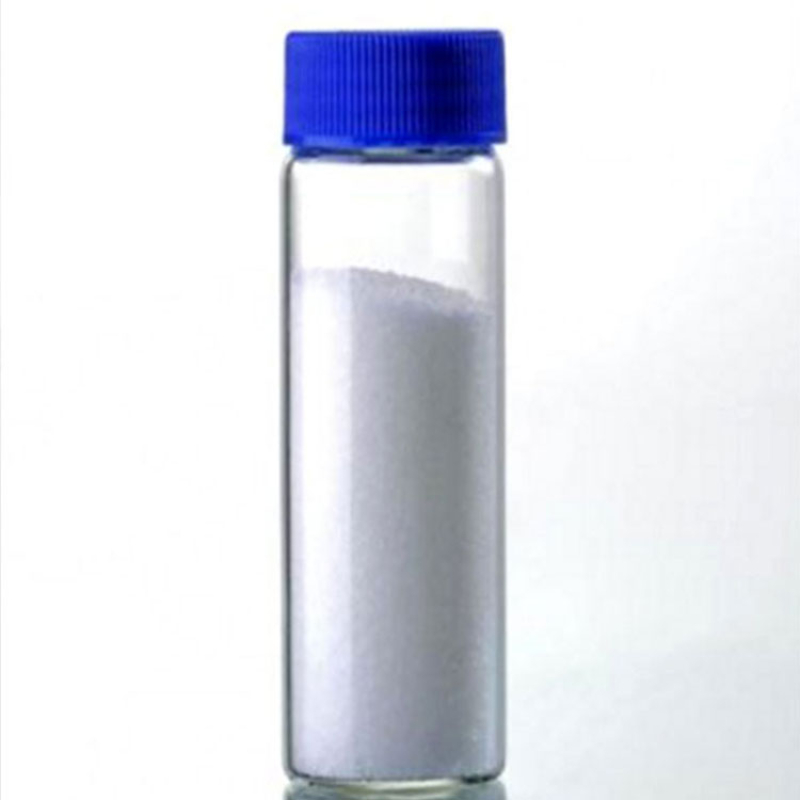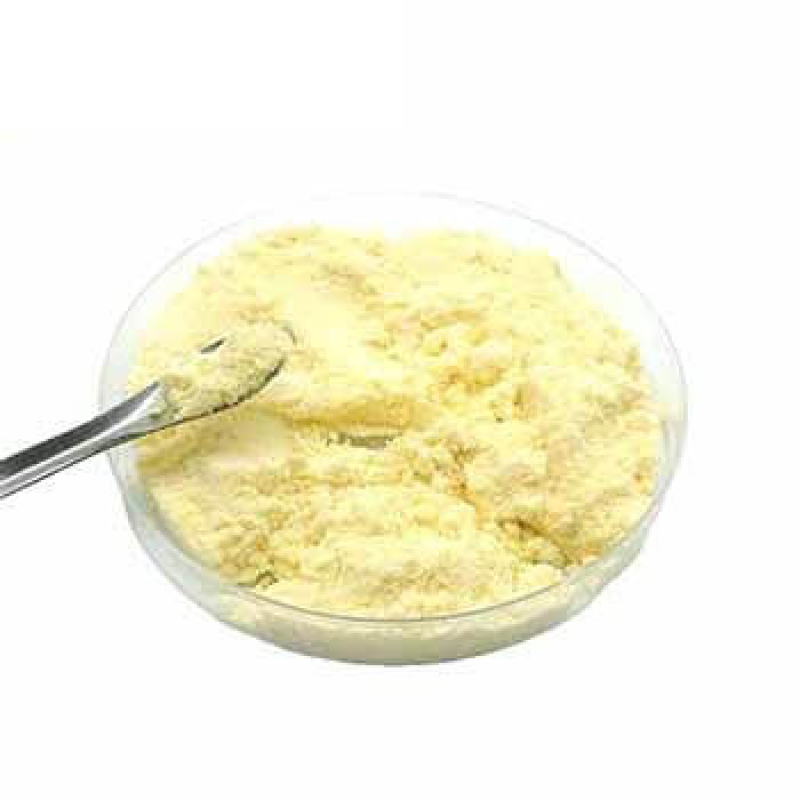Products Description of Ademetionine 1,4-butanedisulfonate CAS#101020-79-5S-Adenosylmethionine 1,4-butanedisulfonate is used to synthesize sulfo-adenosyl-L-methionine (SAMe) salt.Ademetionine 1,4-butanedisulfonate Chemical PropertiesMelting point >48oC (dec.)storage temp. under inert gas (nitrogen or Argon) at 2-8°Csolubility DMSO (Slightly, Heated), Methanol (Slightly), Water (Slightly)form Solidcolor Off-WhiteStability:HygroscopicInChIKeyPVCDYZJGZPCASW-FGEWMKOMNA-MSMILESC(CCCS(O)(=O)=O)S(O)(=O)=O.O[C@@H]1[C@@H]([C@@H](C[S+](C)CC[C@H](N)C(=O)O)O[C@H]1N1C=NC2C(
Kontaktieren Sie mich jetzt
Products Description of 1,4-Benzoquinone CAS#106-51-4Parabenzoquinone is a quinone organic compound. Pure parabenzoquinone is a bright yellow crystal with a pungent smell similar to chlorine. Impure samples are often due to 1 :1 charge transfer complex) exists and the color is dim.
Kontaktieren Sie mich jetzt
1,4-Benzenedicarboxylic Acid, Compds. With Polyisobutenyl Succinic Anhydride-Tetraethylenepentamine Reaction Products CAS:68909-40-0Good dispersibility: It can be effectively dispersed in various solvents and matrices, which helps to improve the uniformity and stability of the product. Excellent thermal stability: It can maintain its stable performance at higher temperatures and is suitable for some high-temperature application scenarios.
Kontaktieren Sie mich jetzt
Products Description of Triethylenediamine CAS#280-57-9Triethylenediamine, also known as 1,4-diazabicyclo〔2.2.2〕octane, or triethylenediamine, abbreviated as DABCO or TEDA in English, has a chemical formula of C6H12N2.
Kontaktieren Sie mich jetzt
Products Description of 1,4-Butanediol dimethacrylate CAS#2082-81-71,4-Butanediol dimethacrylate is used in the preparation and application of hydrogel super absorbent polymers.1,4-Butanediol dimethacrylate Chemical PropertiesMelting point −117 °C(lit.)Boiling point 132-134 °C/4 mmHg (lit.)density 1.023 g/mL at 25 °C (lit.)vapor density 2.09 (vs air)vapor pressure 430 mm Hg ( 25 °C)refractive index n20/D 1.456(lit.)Fp 38 °Fstorage temp. 2-8°Csolubility Chloroform (Sparingly), Methanol (Slightly)form Liquidpka9.8(at 25℃)color
Kontaktieren Sie mich jetzt
Products Description of 1,4-Bis-[4-(3-acryloyloxypropyloxy)benzoyloxy]-2-methylbenzeneCAS#174063-87-71,4-Bis-[4-(3-acryloxypropoxy)benzoyloxy]-2-methylbenzene can be used in the field of photography to synthesize fast-erasable dyes, filter materials, charge transfer agents, etc.1,4-Bis-[4-(3-acryloyloxypropyloxy)benzoyloxy]-2-methylbenzene Chemical PropertiesBoiling point 733.5±60.0 °C(Predicted)density 1.219vapor pressure 0.003Pa at 25℃storage temp. Keep in dark place,Sealed in dry,Room Temperatureform powdercolor WhiteWater Solubility 5.3μg/L at 20℃Log
Kontaktieren Sie mich jetzt
1,4-Butanediol CAS#110-63-41,4-butanediol (1,4-BD) is a colorless, viscous liquid derived from butane with the aid of placement of alcohol organizations at every give up of its molecular chain and is one of 4 secure isomers of butanediol.the hydroxyl feature of every give up crew of the Butanediol reacts with exceptional mono- and bifunctional reagents: for instance with dicarboxylic acids to polyesters, with diisocyanates to polyurethanes, or with phosgene to polycarbonates.
Kontaktieren Sie mich jetzt
Products Description of Maltose CAS#69-79-4Maltose is the abbreviation of maltobiose, also known as D-maltose and maltose. A disaccharide formed by connecting, condensing, and dehydrating two molecules of α-D-glucose through α-1,4 glycosidic bonds. There is also a free hemiacetal hydroxyl group in the molecule, which is a reducing sugar. Like glucose, it can make Doron's reagent and Fehling's reagent react positively.
Kontaktieren Sie mich jetzt
Products Description of Sulfamic acid CAS#5329-14-6Aminosulfonic acid is a colorless, odorless and non-toxic solid strong acid. Its aqueous solution has the same strong acid properties as hydrochloric acid, sulfuric acid, etc., but its corrosiveness to metals is much lower than that of hydrochloric acid, etc. It is extremely toxic to the human body, but it cannot be in contact with the skin for a long time, let alone enter the eyes.Due to its strong acid properties, it is also called solid sulfuric acid.
Kontaktieren Sie mich jetzt
Products Description of Imidazo[1,2-b]pyridazine CAS#766-55-2Imidazolo[1,2-b]pyridazine can be used as a pharmaceutical synthesis intermediate, and can be prepared from 3-pyridazine as a reaction raw material and 2-chloroethylamine hydrochloride, and can be used to prepare 3-ethynylimidazo[1,2-b]pyridazine, an intermediate of ponatinib.Imidazo[1,2-b]pyridazine CAS#766-55-2 Chemical PropertiesMelting point 54℃density 1.29±0.1 g/cm3(Predicted)storage temp. Inert atmosphere,Room Temperaturesolubility Soluble in dimethylformamide.form powder to crystalpka5.30±0.30(Pre
Kontaktieren Sie mich jetzt
Propyl acetate CAS# 109-60-4Chemical Properties:Propyl acetate, also known as propyl acetate, n-propyl acetate, or n-propyl acetate, is a colorless and clear liquid with a soft fruity aroma. Naturally found in strawberries, bananas, and tomatoes. Soluble in most organic solvents such as alcohols, ketones, esters, and oils, and slightly soluble in water.Quality Assurance:We maintain strict quality control to ensure our glacial acetic acid meets the highest purity standards, essential for critical industrial applications.Professional Sales Pitch:As a sales professional, I understand th
Kontaktieren Sie mich jetzt
Products Description of 1,3-Butanediol CAS#107-88-0Transparent colorless hygroscopic viscous liquid with a weak special taste. Almost odorless. Boiling point 207.5℃, relative density (4:1.0059, refractive index (nD20) 1.4401, freezing point <-50℃, flash point 121.1℃. Has a certain antibacterial effect.
Kontaktieren Sie mich jetzt
1,3-Dimercaptopropane CAS #109-80-81, 3-dimercaptopropane is usually a colorless transparent liquid at room temperature.
Kontaktieren Sie mich jetzt
Products Description of Dibenzoylmethane CAS#120-46-71,3-diphenyl-1,3-propanedione is commonly known as dibenzoylmethane.
Kontaktieren Sie mich jetzt
Products Description of 1,3-Dimethylurea CAS#96-31-11,3-Dimethylurea, an organic chemical substance, CAS number: 96-31-1, molecular formula: C3H8N2O.1,3-Dimethylurea Chemical PropertiesMelting point 101-104 °C(lit.)Boiling point 268-270 °C(lit.)density 1.142vapor pressure 6 hPa (115 °C)refractive index 1.4715 (estimate)Fp 157 °Cstorage temp. Store below +30°C.solubility H2O: 0.1 g/mL, clear, colorlesspka14.57±0.46(Predicted)form Crystalscolor WhitePH9.0-9.5 (100g/l, H2O, 20℃)Water Solubility 765 g/L (21.5 ºC)BRN 17
Kontaktieren Sie mich jetzt
Products Description of Glycerol formal CAS#4740-78-7Glycerol acetal (GF) is a light glycerol acetal composed of about 60% 5-hydroxy-1,3-dioxane and about 40% 4-hydroxymethyl-1,3-dioxane. Glycerol reacts with formaldehyde in the presence of an acidic catalyst to produce acetone.
Kontaktieren Sie mich jetzt
Products Description of 2,3,4,5-Tetrafluorobenzoic Acid CAS#1201-31-62,3,4,5-Tetrafluorobenzoic acid is a chemical substance with the molecular formula C7H2F4O2.Colorless flaky crystals.
Kontaktieren Sie mich jetzt
Products Description of OXALIC ACID CAS#68603-87-2Oxalic acid standard solution is mostly used for quantitative detection of oxalic acid content in food and medicine. For example, oxalic acid standard solution can be used to determine the oxalic acid content in edible mushroom broth.
Kontaktieren Sie mich jetzt
Products Description of Dehydroacetic acid CAS#520-45-6DHA is widely found in many deep-sea fish oils, as well as in marine algae and some terrestrial plants. DHA is an ω-3 type unsaturated fatty acid and an essential fatty acid for the body. mp44℃. It is very unstable to light, oxygen and heat, and is easily oxidized and cracked, so antioxidants should usually be added.
Kontaktieren Sie mich jetzt
Products Description of Glycolic acid CAS#79-14-1Glycolic acid, also known as glycolic acid and glycolic acid, is also an important organic synthesis intermediate and chemical product. It is widely used in organic synthesis, cleaning, electroplating, textile, leather, sterilization and other industries.
Kontaktieren Sie mich jetzt
Products Description of Thiosalicylic acid CAS#147-93-3Thiosalicylic acid, o-mercaptobenzoic acid, white triclinic crystals or white solids. Soluble in ethanol and glacial acetic acid, slightly soluble in water. Used in the preparation of thioindigo dyes, and also used as a reagent for iron analysis.
Kontaktieren Sie mich jetzt
Products Description of Oxalic Acid CAS#144-62-7Oxalic acid is an organic substance with the chemical formula H₂C₂O₄. It is a metabolite of organisms, a medium-strong acid, widely distributed in plants, animals and fungi, and plays different functions in different organisms. Studies have found that more than 100 plants are rich in oxalic acid, especially spinach, amaranth, beet, purslane, taro, sweet potato and rhubarb.
Kontaktieren Sie mich jetzt
Products Description of D-Glucal CAS#13265-84-4D-glucosene, also called D-glucosene, is a pharmaceutical intermediate that can be prepared from pentaacetyl glucose through a three-step reaction.
Kontaktieren Sie mich jetzt
Products Description of Sodium trimetaphosphate CAS#7785-84-4Sodium trimetaphosphate is an inorganic compound with the chemical formula Na3(PO3)3. It is a white crystalline powder, easily soluble in water, and is mainly used as a starch modifier.Sodium trimetaphosphate Chemical PropertiesMelting point 53℃ [MER06]density 2.49storage temp. Inert atmosphere,Room Temperaturesolubility Water (Slightly)form Powdercolor WhiteSpecific Gravity2.49Water Solubility Soluble in water.
Kontaktieren Sie mich jetzt







![1,4-Bis-[4-(3-acryloyloxypropyloxy)benzoyloxy]-2-methylbenzeneCAS#174063-87-7](https://sdluxicdn.huazhi.cloud/cdn/ff/UzaxHqC7dqMBX0gCNrVwnr0zZlxBJGLCf_1pR8RV7U8/1719438243/public/styles/chanpinzhutu/public/2024-06/%E7%99%BD%E8%89%B2%E7%B2%89%E6%9C%AB%20%285%29_15.jpg?itok=9zTdC24L)



![Imidazo[1,2-b]pyridazine CAS#766-55-2](https://sdluxicdn.huazhi.cloud/cdn/ff/0zOUVGs0O2UNKg1sLuyBEd5hRn1Q9iSLX8YfXSek5M4/1720183747/public/styles/chanpinzhutu/public/2024-07/16-1_2.jpg?itok=yIuJQIIN)























